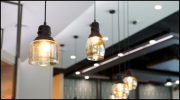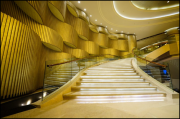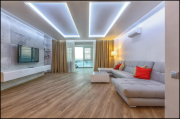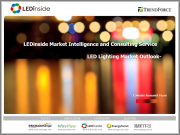
|
시장보고서
상품코드
1677956
조명기구 시장 규모, 점유율, 성장 분석 : 소스별, 제품별, 유통 채널별, 용도별, 지역별 - 산업 예측(2025-2032년)Lighting Fixture Market Size, Share, and Growth Analysis, By Source (Incandescent, Fluorescent), By Product (Ceiling, Pendant and Chandeliers), By Distribution Channel, By Applications, By Region - Industry Forecast 2025-2032 |
||||||
조명기구 시장 규모는 2023년 2,013억 3,000만 달러로 평가되며, 예측 기간(2025-2032년) 동안 10.1%의 CAGR로 2024년 2,216억 6,000만 달러에서 2032년 4,786억 2,000만 달러로 성장할 것으로 예상됩니다.
세계 조명기구 시장은 에너지 효율에 대한 소비자의 관심이 높아지고 첨단 조명 기술에 대한 투자 의지가 높아짐에 따라 크게 성장하고 있습니다. 형광등이나 백열등과 같은 기존 조명기구보다 LED 조명기구를 선호하는 소비자들이 늘어나면서 시장이 확대되고 있으며, IoT 기술과 통합된 스마트 조명 솔루션에 대한 수요도 제조업체들에게 새로운 기회를 창출하고 있습니다. 또한, 맞춤형 조명 디자인에 대한 선호도가 높아짐에 따라 시장 수요가 증가할 가능성이 높습니다. 가정과 사무실의 미관을 개선하기 위한 소비자의 높은 지출은 생활 수준의 발전과 함께 조명기구 공급업체에 대한 가능성으로 가득 찬 미래를 뒷받침하고 있습니다. 전반적으로 이러한 추세는 향후 몇 년 동안 조명기구 산업의 유망한 전망을 제시합니다.
목차
소개
- 조사 목적
- 조사 범위
- 정의
조사 방법
- 정보 조달
- 2차와 1차 데이터 방법
- 시장 규모 예측
- 시장 가정과 제한
주요 요약
- 세계 시장 전망
- 공급과 수요 동향 분석
- 부문별 기회 분석
시장 역학과 전망
- 시장 개요
- 시장 규모
- 시장 역학
- 성장 촉진요인과 기회
- 성장 억제요인과 과제
- Porters 분석
주요 시장 인사이트
- 핵심성공요인
- 경쟁 정도
- 주요 투자 기회
- 시장 생태계
- 시장 매력 지수(2024년)
- PESTEL 분석
- 거시경제 지표
- 밸류체인 분석
- 가격 분석
- 고객과 구매 기준 분석
조명기구 시장 규모 : 소스별 & CAGR(2025-2032년)
- 시장 개요
- 백열등
- 형광
- LED와 OLED
조명기구 시장 규모 : 제품별 & CAGR(2025-2032년)
- 시장 개요
- 실링
- 펜던트와 샹들리에
- 벽걸이
- 휴대용
- 기타
조명기구 시장 규모 : 유통 채널별 & CAGR(2025-2032년)
- 시장 개요
- 온라인
- 오프라인
조명기구 시장 규모 : 용도별 & CAGR(2025-2032년)
- 시장 개요
- 주거용
- 상업용
조명기구 시장 규모 : 지역별 & CAGR(2025-2032년)
- 북미
- 미국
- 캐나다
- 유럽
- 독일
- 스페인
- 프랑스
- 영국
- 이탈리아
- 기타 유럽
- 아시아태평양
- 중국
- 인도
- 일본
- 한국
- 기타 아시아태평양
- 라틴아메리카
- 브라질
- 기타 라틴아메리카
- 중동 및 아프리카
- GCC 국가
- 남아프리카공화국
- 기타 중동 및 아프리카
경쟁 정보
- 상위 5개사의 비교
- 주요 기업의 시장 포지셔닝(2024년)
- 주요 시장 기업이 채용한 전략
- 최근의 시장 동향
- 기업의 시장 점유율 분석(2024년)
- 주요 기업 개요
- 기업 상세
- 제품 포트폴리오 분석
- 기업 부문별 점유율 분석
- 매출 전년비 비교(2022-2024년)
주요 기업 개요
- Signify N.V.(Netherlands)
- Acuity Brands, Inc.(USA)
- OSRAM Licht AG(Germany)
- Panasonic Corporation(Japan)
- Zumtobel Group AG(Austria)
- Hubbell Incorporated(USA)
- Cree, Inc.(USA)
- Fagerhult Group(Sweden)
- GE Lighting(USA)
- Eaton Corporation plc(Ireland)
- Schneider Electric SE(France)
- Lutron Electronics Company, Inc.(USA)
- Delta Light(Belgium)
- NVC Lighting Holding Limited(China)
- Opple Lighting Co., Ltd.(China)
- Havells India Limited(India)
- Thorn Lighting(UK)
- LSI Industries Inc.(USA)
결론과 제안
ksm 25.04.18Lighting Fixture Market size was valued at USD 201.33 billion in 2023 and is poised to grow from USD 221.66 billion in 2024 to USD 478.62 billion by 2032, growing at a CAGR of 10.1% during the forecast period (2025-2032).
The global lighting fixture market is witnessing significant growth, driven by a rising emphasis on energy efficiency and consumer willingness to invest in advanced lighting technologies. As consumers increasingly favor LED lighting fixtures over traditional options like fluorescent and incandescent, the market is poised for expansion. The demand for smart lighting solutions integrated with IoT technology is also creating new opportunities for manufacturers. Additionally, the growing preference for customized lighting designs is likely to enhance market demand. High consumer expenditure on enhancing home and office aesthetics, coupled with evolving living standards, underscores a future filled with potential for lighting fixture providers. Overall, these trends suggest a promising outlook for the lighting fixture industry in the coming years.
Top-down and bottom-up approaches were used to estimate and validate the size of the Lighting Fixture market and to estimate the size of various other dependent submarkets. The research methodology used to estimate the market size includes the following details: The key players in the market were identified through secondary research, and their market shares in the respective regions were determined through primary and secondary research. This entire procedure includes the study of the annual and financial reports of the top market players and extensive interviews for key insights from industry leaders such as CEOs, VPs, directors, and marketing executives. All percentage shares split, and breakdowns were determined using secondary sources and verified through Primary sources. All possible parameters that affect the markets covered in this research study have been accounted for, viewed in extensive detail, verified through primary research, and analyzed to get the final quantitative and qualitative data.
Lighting Fixture Market Segments Analysis
Global Lighting Fixture Market is segmented by Source, Product, Distribution Channel, Applications and region. Based on Source, the market is segmented into Incandescent, Fluorescent and LED andOLED. Based on Product, the market is segmented into Ceiling, Pendant and Chandeliers, Wall Mounted, Portable and Others. Based on Distribution Channel, the market is segmented into Online and Offline. Based on Applications, the market is segmented into Residential and Commercial. Based on region, the market is segmented into North America, Europe, Asia Pacific, Latin America and Middle East & Africa.
Driver of the Lighting Fixture Market
The global emphasis on sustainability is expected to drive the adoption of energy-efficient lighting solutions, thereby supporting growth in the lighting fixture market. As energy-efficient LEDs and various other lighting options become more widely available, this trend is likely to create new opportunities for participants in the lighting fixture industry. The increasing demand for eco-friendly products aligns with a broader commitment to reducing energy consumption, further enhancing market prospects. Consequently, lighting fixture manufacturers and suppliers are well-positioned to capitalize on this shift towards sustainable practices, which will positively influence their innovation and product development strategies moving forward.
Restraints in the Lighting Fixture Market
The lighting fixture market faces notable restraints primarily due to the initial high costs associated with modern lighting solutions. While investing in energy-efficient and advanced fixtures can be beneficial over time, the upfront expense may discourage potential buyers, particularly in price-sensitive markets with limited purchasing power. The significantly higher costs of smart lighting options compared to traditional fixtures create a barrier for many consumers. Consequently, this financial hesitancy can impede the adoption of innovative lighting technologies, ultimately slowing down market growth and limiting the transition to more sustainable solutions in environments where budget constraints are a significant concern.
Market Trends of the Lighting Fixture Market
The Lighting Fixture market is experiencing a transformative shift, primarily driven by the dominance of LED technology. With their prolonged lifespan, superior illumination quality, and enhanced energy efficiency, LED lighting fixtures are projected to captivate a significant portion of the global lighting market. As sustainability becomes a pivotal concern for consumers and businesses alike, the demand for eco-friendly LED solutions is set to surge. Additionally, the integration of LEDs into smart lighting systems, which offer advanced control and automation features, further propels their adoption. This trend underscores a comprehensive move towards innovative, energy-efficient, and sustainable lighting solutions in the industry.
Table of Contents
Introduction
- Objectives of the Study
- Scope of the Report
- Definitions
Research Methodology
- Information Procurement
- Secondary & Primary Data Methods
- Market Size Estimation
- Market Assumptions & Limitations
Executive Summary
- Global Market Outlook
- Supply & Demand Trend Analysis
- Segmental Opportunity Analysis
Market Dynamics & Outlook
- Market Overview
- Market Size
- Market Dynamics
- Drivers & Opportunities
- Restraints & Challenges
- Porters Analysis
- Competitive rivalry
- Threat of substitute
- Bargaining power of buyers
- Threat of new entrants
- Bargaining power of suppliers
Key Market Insights
- Key Success Factors
- Degree of Competition
- Top Investment Pockets
- Market Ecosystem
- Market Attractiveness Index, 2024
- PESTEL Analysis
- Macro-Economic Indicators
- Value Chain Analysis
- Pricing Analysis
- Customer & Buying Criteria Analysis
Global Lighting Fixture Market Size by Source & CAGR (2025-2032)
- Market Overview
- Incandescent
- Fluorescent
- LED and OLED
Global Lighting Fixture Market Size by Product & CAGR (2025-2032)
- Market Overview
- Ceiling
- Pendant and Chandeliers
- Wall Mounted
- Portable
- Others
Global Lighting Fixture Market Size by Distribution Channel & CAGR (2025-2032)
- Market Overview
- Online
- Offline
Global Lighting Fixture Market Size by Applications & CAGR (2025-2032)
- Market Overview
- Residential
- Commercial
Global Lighting Fixture Market Size & CAGR (2025-2032)
- North America (Source, Product, Distribution Channel, Applications)
- US
- Canada
- Europe (Source, Product, Distribution Channel, Applications)
- Germany
- Spain
- France
- UK
- Italy
- Rest of Europe
- Asia Pacific (Source, Product, Distribution Channel, Applications)
- China
- India
- Japan
- South Korea
- Rest of Asia-Pacific
- Latin America (Source, Product, Distribution Channel, Applications)
- Brazil
- Rest of Latin America
- Middle East & Africa (Source, Product, Distribution Channel, Applications)
- GCC Countries
- South Africa
- Rest of Middle East & Africa
Competitive Intelligence
- Top 5 Player Comparison
- Market Positioning of Key Players, 2024
- Strategies Adopted by Key Market Players
- Recent Developments in the Market
- Company Market Share Analysis, 2024
- Company Profiles of All Key Players
- Company Details
- Product Portfolio Analysis
- Company's Segmental Share Analysis
- Revenue Y-O-Y Comparison (2022-2024)
Key Company Profiles
- Signify N.V. (Netherlands)
- Company Overview
- Business Segment Overview
- Financial Updates
- Key Developments
- Acuity Brands, Inc. (USA)
- Company Overview
- Business Segment Overview
- Financial Updates
- Key Developments
- OSRAM Licht AG (Germany)
- Company Overview
- Business Segment Overview
- Financial Updates
- Key Developments
- Panasonic Corporation (Japan)
- Company Overview
- Business Segment Overview
- Financial Updates
- Key Developments
- Zumtobel Group AG (Austria)
- Company Overview
- Business Segment Overview
- Financial Updates
- Key Developments
- Hubbell Incorporated (USA)
- Company Overview
- Business Segment Overview
- Financial Updates
- Key Developments
- Cree, Inc. (USA)
- Company Overview
- Business Segment Overview
- Financial Updates
- Key Developments
- Fagerhult Group (Sweden)
- Company Overview
- Business Segment Overview
- Financial Updates
- Key Developments
- GE Lighting (USA)
- Company Overview
- Business Segment Overview
- Financial Updates
- Key Developments
- Eaton Corporation plc (Ireland)
- Company Overview
- Business Segment Overview
- Financial Updates
- Key Developments
- Schneider Electric SE (France)
- Company Overview
- Business Segment Overview
- Financial Updates
- Key Developments
- Lutron Electronics Company, Inc. (USA)
- Company Overview
- Business Segment Overview
- Financial Updates
- Key Developments
- Delta Light (Belgium)
- Company Overview
- Business Segment Overview
- Financial Updates
- Key Developments
- NVC Lighting Holding Limited (China)
- Company Overview
- Business Segment Overview
- Financial Updates
- Key Developments
- Opple Lighting Co., Ltd. (China)
- Company Overview
- Business Segment Overview
- Financial Updates
- Key Developments
- Havells India Limited (India)
- Company Overview
- Business Segment Overview
- Financial Updates
- Key Developments
- Thorn Lighting (UK)
- Company Overview
- Business Segment Overview
- Financial Updates
- Key Developments
- LSI Industries Inc. (USA)
- Company Overview
- Business Segment Overview
- Financial Updates
- Key Developments



















